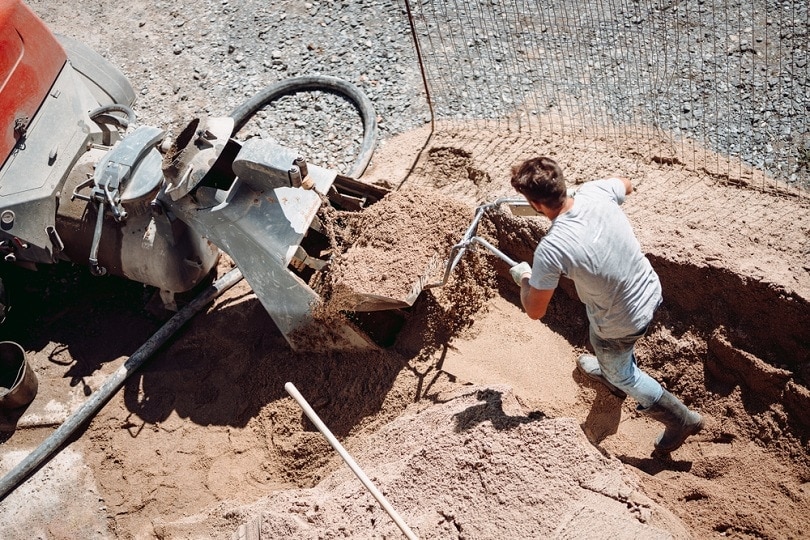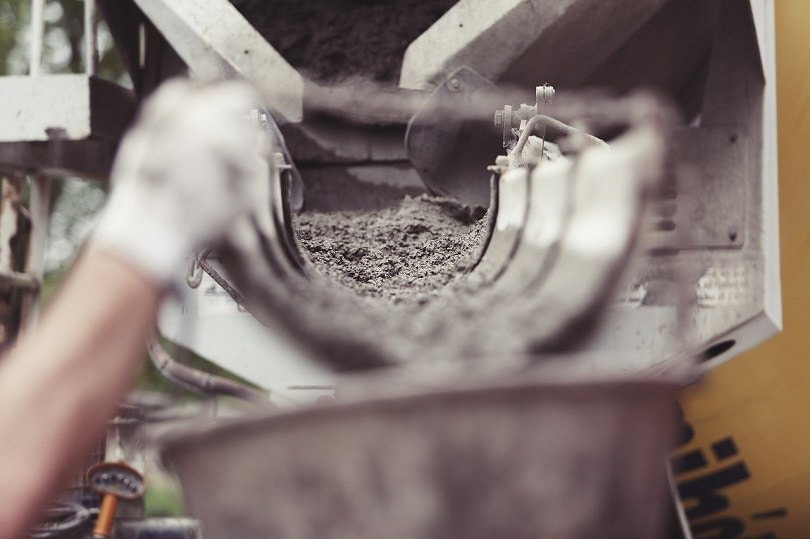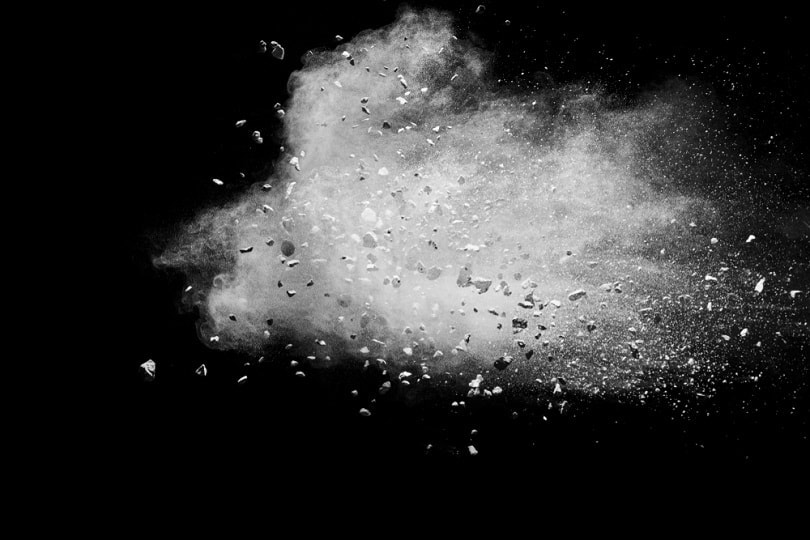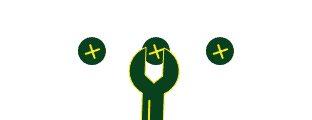4 Polymeric Sand Alternatives: Pros & Cons (With Pictures)
-

- Last updated:


This is the easiest way to use pavers. However, it is easy to run out of sand in the middle of a project or be unable to find any in your area. Luckily, there are a few alternatives. It is essential to point out that none of these alternatives are as good as the real thing, but they can work in a pinch.
The 4 Polymeric Sand Alternatives
1. Builder’s Sand

Builder’s sand is the most common replacement for polymeric sand, and it is easy to access and affordable. It is used heavily in construction projects, hence its name. Because the sand is very coarse, you must use it regularly. You’ll have to reapply it for years as it settles. It is very cheap, so multiple applications will not cost much.
Builder’s sand is very prone to erosion, which can occur during heavy rainfall or high winds. It may need extra attention after these periods of disruption. Another effective solution is to use mechanical compactors when you use the sand. However, not everyone has a mechanical compactor lying around.
You can rent a machine, but you’re ruining the cost-effectiveness of the sand at that point. Plus, if you don’t have time to get polymeric sand, you probably don’t have time to get a compactor, either.
Furthermore, builder’s sand is often affected by animals and plants. For example, ants love it and will carry it away. Typically, this isn’t an issue since there aren’t enough ants to make a dent in the sand. In some areas, it can be a problem. Plus, it attracts ants to your pavers, which may cause issues.
Weeds can also grow in the sand and must be pulled out regularly. Larger weeds can disrupt the sand with their roots. However, plants may also prevent erosion, so many people see them as a good thing.
- Inexpensive
- Easy to use
- Accessible
- Erodes easily
2. Cement

Cement may be a reliable option if you want a material that will stay put. Cement doesn’t erode, and it’s a trendy choice for keeping just about anything in place, including pavers.
To use cement with your pavers, you’ll need to lay down a cement base and then push the pavers into it. Once the pavers are placed, they cannot be removed without a jackhammer. You must get them in the right place the first time.
Cement is more stable than most other options. For this reason, it is a reliable material if stability is essential to you. However, you can’t precisely re-add cement whenever it wears out. Instead, you’ll have to redo the whole project. This is one of the downsides of cement, but the pavers will likely stay in place for an extended period.
If you only want the cement to fill the holes between the pavers, you can pour the cement between the pavers. This is a bit more time-consuming and requires a lot of patience, but it can be another good option. It will not create an entirely solid surface, so there isn’t as much cement involved.
Cement is inexpensive and one of the more prevalent alternatives to polymeric sand. However, it does take a bit more skill to use since you won’t get a do-over.
- Will not erode
- Very stable
- Long-lasting
- Requires skill to use
3. Stone Dust

Stone dust is a by-product of crushed stone like gravel. It’s composed of tiny pieces that don’t make it into the completed product. This by-product can be beneficial for paver projects, as it is a rougher version of sand. Besides being an alternative to polymeric sand, stone dust can be used in landscaping and paving driveways. It is a versatile “waste product.”
The dust is very easy to lay as a flat surface for pavers. You can apply multiple layers to ensure that it will last for an extended period. You can also use it as a filler between the stones and prevent weeds from growing. It makes your patio look neat and tidy and is easy to work with.
It also prevents water from seeping underneath the pavers, which can make them shift and slide. It is non-porous so that it won’t get wet either. It will drain the water off the pavers instead of soaking into the area below the patio. This can prevent water from sitting next to your house. Plus, it is incredibly inexpensive!
- Inexpensive
- Easy to use
- Versatile
- Erodes
4. Plain Sand

Many people use plain sand as an alternative to polymeric sand. While it can work, sand is not as suitable for filling the area between pavers. Sand is very prone to erosion and will wash away. This may not be a massive problem since sand is cheap, but it requires more work to maintain.
Regular sand also doesn’t prevent weeds or ants, and it doesn’t come in many colors, so you’re stuck with just a plain, tan option. On the good side, sand is very inexpensive and accessible. Many stores have sand—even those that aren’t explicitly construction-related.
- Inexpensive
- Easy to Find
- Prone to erosion
- Only comes in one color
 Frequently Asked Questions
Frequently Asked Questions
When using an alternative to polymeric sand, you may have many questions. We’ll answer some of the questions below so you can choose the best alternative for you (or skip choosing an alternative altogether).
Can you make your polymeric sand?
Some companies sell polymeric sand concentrated, which you mix with regular sand or other products. However, you have to purchase the concentrate. You can’t make polymeric sand easily from anything accessible to most homeowners. For this reason, choosing an alternative rather than trying to make your own is a more straightforward option.
Does polymeric sand wash away?
Polymeric sand includes chemical binders that harden when water is added. When you use it, you add water to it to harden it. This prevents the sand from washing away and keeps the weeds and ants away.
This is one of the main benefits of polymeric sand when compared to many of the alternatives.
Is polymeric sand necessary?
Polymeric sand is the go-to material for filling the joints when putting down pavers. However, that doesn’t make it the only option. There are quite a few alternatives that you may find helpful if you can’t find polymeric sand.
Each alternative has its pros and cons. You aren’t going to find another construction material that will act precisely like polymeric sand, but there are several that do a good enough job for most projects.
Can I use cement instead of polymeric sand?
Yes. Cement is harder to apply and may not hold up as long, depending on your location and climate. Cement is one of the better alternatives to polymeric sand.
Conclusion
Polymeric sand is the ideal material for laying pavers on your property, but it’s not as easy to find as some of the alternatives. Builder’s sand and plain sand are the easiest substitutes to use, but require more maintenance. However, they’re affordable and readily available. Although cement is trickier to work with if you’re unfamiliar with it, it doesn’t require much maintenance and is a longer-lasting alternative than the other materials we discussed.
Featured Image Credit: bogdanhoda, Shutterstock
Contents

 Frequently Asked Questions
Frequently Asked Questions